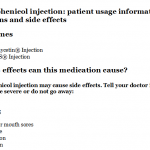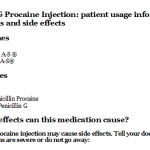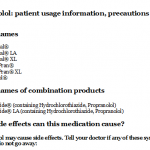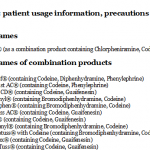
Fluzone Intradermal Quadrivalent Influenza Vaccine: patient information, prescribing information, ingredients, manufacturer, adverse reactions and side effects
Friday, April 07, 2017 by Gregory Van Dyke
http://www.naturalnewsreference.com/2017-04-07-fluzone-intradermal-quadrivalent-influenza-vaccine-patient-information-prescribing-information-ingredients-manufacturer-adverse-reactions-and-side-effects.html
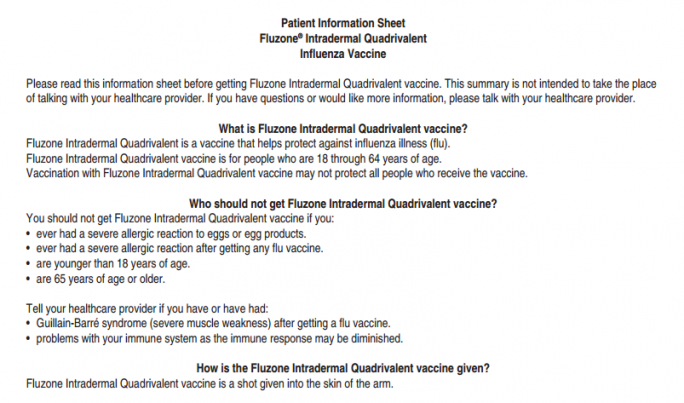
HIGHLIGHTS OF PRESCRIBING INFORMATION
These highlights do not include all the information needed to use Fluzone® Intradermal Quadrivalent safely and effectively. See full prescribing information for Fluzone Intradermal Quadrivalent.
See full insert sheet at this link at the Natural News Reference website.
Fluzone Intradermal Quadrivalent (Influenza Vaccine)
Suspension for Intradermal Injection
2016-2017 Formula
Initial US Approval (Fluzone Intradermal Quadrivalent): 2014
INGREDIENTS AND EXCIPIENTS
Fluzone Intradermal Quadrivalent (Influenza Vaccine) for intradermal injection is an inactivated influenza vaccine, prepared from influenza viruses propagated in embryonated chicken eggs. The virus-containing allantoic fluid is harvested and inactivated with formaldehyde. Influenza virus is concentrated and purified in a linear sucrose density gradient solution using a continuous flow centrifuge. The virus is then chemically disrupted using a non-ionic surfactant, octylphenol ethoxylate (Triton® X-100), producing a “split virus”. The split virus is further purified and then suspended in sodium phosphate-buffered isotonic sodium chloride solution. The Fluzone Intradermal Quadrivalent process uses an additional concentration factor after the ultrafiltration step in order to obtain a higher hemagglutinin (HA) antigen concentration. Antigens from the four strains included in the vaccine are produced separately and then combined to make the quadrivalent formulation.
Fluzone Intradermal Quadrivalent suspension for injection is clear and slightly opalescent in color.
Neither antibiotics nor preservative are used in the manufacture of Fluzone Intradermal Quadrivalent.
The Fluzone Intradermal Quadrivalent microinjection system is not made with natural rubber latex.
Fluzone Intradermal Quadrivalent is standardized according to United States Public Health Service requirements and is formulated to contain the following four influenza strains recommended for the 2016-2017 influenza season: A/California/07/2009 X-179A (H1N1), A/Hong Kong/4801/2014 X-263B(H3N2), B/Phuket/3073/2013 (B Yamagata lineage), and B/Brisbane/60/2008 (B Victoria lineage). The amounts of HA and other ingredients per dose of vaccine are listed in Table 3.
Table 3: Fluzone Intradermal Quadrivalent Ingredients
|
Ingredient |
Quantity per 0.1 mL Dose |
| Active Substance: Split influenza virus, inactivated strainsa : | 36 mcg HA total |
|
A (H1N1) |
9 mcg HA |
|
A (H3N2) |
9 mcg HA |
|
B/(Victoria lineage) |
9 mcg HA |
|
B/(Yamagata lineage) |
9 mcg HA |
|
Ingredient |
Quantity per 0.1 mL Dose |
| Other: | |
|
Sodium phosphate-buffered isotonic sodium chloride solution |
QSb to appropriate volume |
|
Formaldehyde |
≤20 mcg |
|
Octylphenol ethoxylate |
≤55 mcg |
aper United States Public Health Service (USPHS) requirement
bQuantity Sufficient
INDICATIONS AND USAGE
Fluzone Intradermal Quadrivalent is a vaccine indicated for active immunization for the prevention of influenza disease caused by influenza A subtype viruses and type B viruses contained in the vaccine. (1)
Fluzone Intradermal Quadrivalent is approved for use in persons 18 through 64 years of age. (1)
DOSAGE AND ADMINISTRATION
For intradermal use only (2) – A single 0.1 mL dose for intradermal injection in adults 18 through 64 years of age. (2.1)
DOSAGE FORMS AND STRENGTHS
Suspension for injection in a prefilled microinjection system, 0.1 mL. (3)
CONTRAINDICATIONS
Severe allergic reaction (e.g., anaphylaxis) to any component of the vaccine, including egg protein, or after previous dose of any influenza vaccine. (4)
WARNINGS AND PRECAUTIONS
If Guillain-Barré syndrome (GBS) has occurred within 6 weeks following previous influenza vaccination, the decision to give Fluzone Intradermal Quadrivalent should be based on careful consideration of the potential benefits and risks. (5.1)
ADVERSE REACTIONS
The most common (≥ 5%) systemic adverse reactions observed in clinical trials were upper respiratory tract infections, headache, nasal congestion, pharyngolaryngeal pain, cough, arthralgia, nausea, abdominal pain, diarrhea, and vomiting. (6)
To report SUSPECTED ADVERSE REACTIONS, contact Teva Women’s Health at 1-866-626-6990 or VAERS at 1-800-822-7967 or www.vaers.hhs.gov.
USE IN SPECIFIC POPULATIONS
Pregnancy Category B
The developmental and reproductive toxicity study performed with the trivalent formulation of Fluzone Intradermal is relevant to Fluzone Intradermal Quadrivalent because both vaccines share the same manufacturing process and route of administration. The study, in which the trivalent formulation of Fluzone Intradermal (27 mcg) was administered to female rabbits at a dose approximately 20 times the human dose (on a mg/kg basis), revealed no evidence of impaired female fertility or harm to the fetus. There are, however, no adequate and well-controlled studies in pregnant women. Because animal reproduction studies are not always predictive of human response, Fluzone Intradermal Quadrivalent should be used during pregnancy only if clearly needed.
Sanofi Pasteur Inc. is maintaining a prospective pregnancy exposure registry to collect data on pregnancy outcomes and newborn health status following vaccination with Fluzone Intradermal Quadrivalent during pregnancy. Healthcare providers are encouraged to enroll women who receive Fluzone Intradermal Quadrivalent during pregnancy in Sanofi Pasteur Inc.’s vaccination pregnancy registry by calling 1-800-822-2463.
Nursing Mothers
It is not known whether Fluzone Intradermal Quadrivalent is excreted in human milk. Because many drugs are excreted in human milk, the decision to give Fluzone Intradermal Quadrivalent to a nursing woman should be based on careful consideration of the potential benefits and risks.
Pediatric Use
Safety and effectiveness of Fluzone Intradermal Quadrivalent in persons <18 years of age have not been established. In a clinical trial, 97 infants and toddlers 6 months through 35 months of age and 160 children 3 years through 8 years of age were enrolled to receive two injections of the trivalent formulation of Fluzone Intradermal. Infants and children in a control group received two injections of Fluzone. Fluzone Intradermal was associated with increased local reactogenicity relative to Fluzone. The size of the study was not adequate to reliably evaluate serious adverse events or the immune response elicited by Fluzone Intradermal relative to Fluzone.
Geriatric Use
Safety and effectiveness of Fluzone Intradermal Quadrivalent in persons 65 years of age and older have not been established.
Safety and effectiveness of Fluzone Intradermal Quadrivalent have not been established in pregnant women. (8.1)
Pregnancy: Pregnancy registry available. Call Sanofi Pasteur Inc. at 1-800-822-2463. (8.1)
Issue date: June 2016
https://www.vaccineshoppe.com/image.cfm?doc_id=12952&image_type=pis_pdf
Tagged Under: Tags: dosage, Fluzone, Fluzone Intradermal Quadrivalent, ingredients, insert sheet, side effects, usage, warnings

